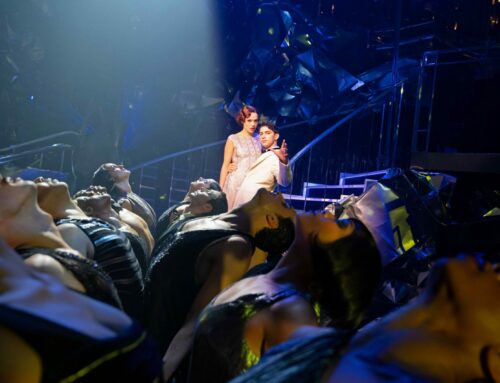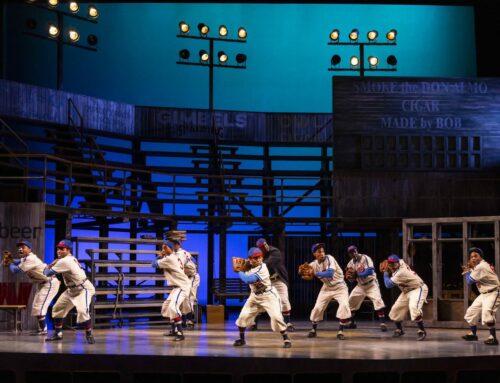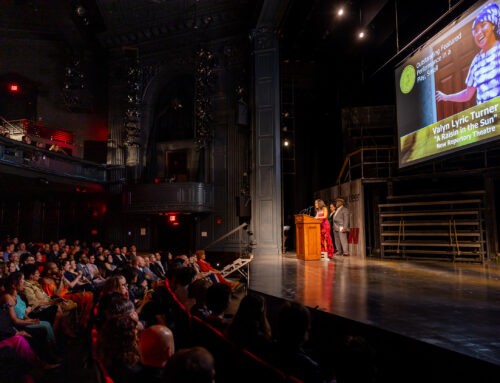I’ve just seen 4 plays in 10 days. Here are two of them– more to come!
MUST SEE: JOHN PROCTOR IS THE VILLAIN presented by THE HUNTINGTON at CALDERWOOD/BCA
Look out Arthur Miller. Playwright Kimberly Belflower has flipped the script on witches, bitches, and snitches in a crucible of a play about predation, patriarchy, and power. I left as fired up as these teenage girls. A HS English class in a self-described “one-stoplight town” in Appalachia is reading Arthur Miller’s THE CRUCIBLE. But first, hunky teacher Carter Smith (charismatic Japhet Balaban) puts the class through its paces with 10 minutes of required sex-ed curriculum, which cleverly plants the thematic seeds about to sprout. It’s 2018 and #Me too has made its way into this rural Georgia H.S. just as these teenage girls (who also want to start a “Feminist” club) are coming into their own. They’re questioning everything about their bodies, their boyfriends, and the meaning of Miller’s classic. Their conversations and the re-entry of the rebellious Shelby (a volatile Isabel Van Natta) who’s been away for a semester, ignites a series of revelations and revolutions.
You’ll recognize yourself among this cast of H.S. characters, from super nerd Beth (Jules Talbot) to super cool Nell (Victoria Omoregie), and among the boys there’s tall “macho” boyfriend Lee (Benjamin Izaak), and his polar opposite the dopey but willing-to-learn Mason (Maanav Aryan Goyal). Notably, all of these characters and performances rise above type to engage us as young adults suddenly in the throes of gender/power politics, inherited cultural mores, and their own sex drives.
Belflower’s seriously funny script and Margot Bordelon’s direction on a lean set, fast forward us through the action which includes transitional music and movement between scenes. Belflower’s play made me want to reread THE CRUCIBLE, and gobsmacked me with a twist I should have seen coming. In its final moments, the play triumphantly liberates Miller’s classic from its traditional interpretive moorings, and with some cut-loose choreography set to Lorde’s “Greenlight” lifts the last scene to heaven or hell–depending on where you’re sitting and what’s crept up on your conscience. If I were still teaching HS English I’d bring the whole class and get ready for a killer debate. MUST SEE JOHN PROCTOR IS THE VILLAIN through March 10, 2024!
SEE: BECOMING A MAN presented by AMERICAN REPERTORY THEATER at Loeb Drama Center
Eye-opening, though dramatically undeveloped, this world premiere production is co-directed by Artistic Director Diane Paulus and P. Carl on whose memoir it is based. BECOMING A MAN is fifty-something Carl’s (Petey Gibson) tale of transition, from girl to queer woman formerly named Polly (Stacey Raymond) to trans man and the ripple effect of those changes on Carl’s own sense of himself and those around him especially his wife Lynette (Elena Hurst). The irony is that inside, Carl was always Carl— he just didn’t look or fully feel that way.
The play literally begins at the end. Carl stands center stage and proclaims, “I am finally me…!” The audience bursts into applause, and mind you, though a Cambridge audience would tend to be receptive, it was immediately clear how anybody could relate to the euphoria driving that opening line. The play then hurtles back and forth in time with actors in multiple roles, attempting to cover a lot of ground — internal and external. This one-act play followed by a 20-minute Act II conversation with the audience only scratches the surface.
On a spare stage, we flash on scenes from Polly’s dysfunctional family, her angry, self-absorbed dying father (Christopher Liam Moore), downtrodden mom (Susan Rome, who also plays his therapist), big-hearted swim coach (Justin Davis), best friend Nathan (Cody Sloan), and wife Lynette who now finds herself part of a straight couple married to a man, instead of in a lesbian marriage to a woman. And her husband is giving off more than a whiff of toxic masculinity, which Carl in the first flush of his manliness has embraced with abandon! He suspects he’s being kind of a d–k but can’t resist.
Lynette is adrift and resentful. She married Polly not Carl. Should Carl have consulted his wife before transitioning? Is Lynette still attracted to her now bearded husband? A girlfriend asks Lynette–is she still a lesbian? Will she leave him? Lynette’s also dealing with a medical crisis of her own. Carl also feels alone and angry. He has never felt at home in his skin, has just undergone the biggest transition of his life, and now for the first time is himself but his partner does not see him or share his joy, and in fact is rejecting him just when he feels more himself than ever before. The play makes clear the conundrum: how a partner, a parent, a friend could feel some combination of betrayal, sadness, and anger at such a dynamic shift– in equal proportion to the liberation that would be experienced by the person experiencing that shift and who feels fully themselves for the first time.
What is the connection between the externality of gender and the internal landscape of a person transitioning as it relates to marriage? To the politics of identity? To a sexual relationship? To a style of communicating? What is it to feel fully embodied? To become a man? A woman? Both? Not fully either? The play raises many questions and suggests that this is but one story, and that each of us is on a continuum of becoming. This material calls for two or three acts, characters fully fleshed out (no pun intended) and a deeper exploration of the issues raised in order to be a more satisfying dramatic experience. As is, BECOMING A MAN is a brave tale in these toxic times; kudos to P. Carl for being so vulnerable, raising these questions, and affording us the opportunity to see another facet of our human condition more clearly. SEE BECOMING A MAN through March 10.






